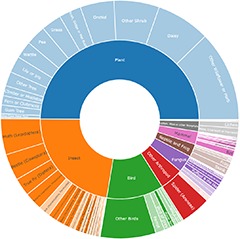Rats
Identification of small mammals from photos is uncertain. It helps to have multiple photos, preferably with a scale in all images, showing: the ratio of tail-length to body-length; the nature of the ears, including how far the ear lobe will reach, in relation to the eye, when the ear lobe is folded forward; the pads under the hind feet; the fur above and below the body, any markings on the head or face; and the scales and fur on the tail.
Announcements
There are currently no announcements.
Discussion
DonFletcher
wrote:
20 Nov 2025
No scale. Ears not visible, No head view, Tail not fully included in photo so ratio of tail length to body length unknown, Tail scale pattern and hairiness not resolved, Cant see hind foot pads. Fur detaching from body due to decomposition gives false sense of long fur like Mastacomys. Identified purely on complete absence of rat records other than of Rattus rattus in Canberra suburbs.
Rattus rattus
MichaelBedingfield
wrote:
10 Nov 2025
Hello Leanne. We are an evidence based website. Did you get a photo to upload?
Hydromys chrysogaster
MichaelBedingfield
wrote:
29 Oct 2025
Very good Aranti. They are marvellous little creatures.
Hydromys chrysogaster
Aranti
wrote:
29 Oct 2025
@MichaelBedingfield I think I've managed it now - transferred to my laptop. Thank you for verifying. I was so excited to see it again and capture it on film. I hope they thrive in there!
Hydromys chrysogaster
MichaelBedingfield
wrote:
28 Oct 2025
I can't see any images, but I've confirmed your sighting. Rakali have been recorded in Gungahlin Pond before.
Hydromys chrysogaster
Top contributors
- AustralianPlatypusConservancy 204
- Waterwatch 131
- Gaia 54
- RodDeb 31
- AlisonMilton 24
- PEdwards 22
- davidcunninghamwildlife 21
- rawshorty 21
- MartinPredavec 19
- MB 18
Top moderators
- DonFletcher 164
- Waterwatch 139
- MartinPredavec 136
- JoelStibbardBCT 81
- MichaelBedingfield 77
- MichaelMulvaney 72
- Gaia 56
- Liam.m 33
- davidcunninghamwildlife 32
- BelindaWilson 10










